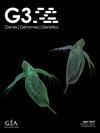局部适应可导致种群内核苷酸多样性出现高峰和低谷
IF 2.1
3区 生物学
Q3 GENETICS & HEREDITY
引用次数: 0
摘要
种群内存在的长期变异量是种群遗传学关注的一个基本量,通常通过计算核苷酸序列对之间的平均差异数(核苷酸多样性,π)来表示。众所周知,背景选择和正选择都会导致核苷酸多样性的降低,但局部适应如何影响核苷酸多样性则不太清楚。根据假设和参数的不同,一些理论研究强调了局部适应如何减少核苷酸多样性,而另一些研究则表明局部适应可以增加核苷酸多样性。在这里,我们探讨了局部适应如何塑造种群内核苷酸多样性的全基因组模式,并扩展了之前的工作,研究了多基因适应、基因型冗余和种群结构的影响。我们的研究表明,根据迁移和选择的相对强度,局部适应会产生两种截然不同的模式,要么显著降低,要么显著增加处于平衡状态的关联位点的种群内多样性。在低迁移率的情况下,多样性降低的区域可能会从因果位点延伸到很远的地方,被侵蚀的多样性大大超过背景选择的预期。随着迁移量的增加,峰值出现在更小的基因组距离上,但多样性的变化幅度却更大。在空间扩展的环境梯度中,这两种模式都可以在单一物种中找到,多样性在范围中心增加,向边缘减少。我们的研究结果表明,基于种群内核苷酸多样性的局部适应并不存在普遍的诊断特征,因此它并不能广泛地用于解释 FST 的增加。然而,鉴于背景和正向选择都不会使多样性增加,当发现峰值时,它们表明局部适应可能作用于该区域的一个因果等位基因。本文章由计算机程序翻译,如有差异,请以英文原文为准。
Local adaptation can cause both peaks and troughs in nucleotide diversity within populations
The amount of standing variation present within populations is a fundamental quantity of interest in population genetics, commonly represented by calculating the average number of differences between pairs of nucleotide sequences (nucleotide diversity, π). It is well understood that both background and positive selection can cause reductions in nucleotide diversity, but less clear how local adaptation affects it. Depending on the assumptions and parameters, some theoretical studies have emphasized how local adaptation can reduce nucleotide diversity, while others have shown that it can increase it. Here, we explore how local adaptation shapes genome-wide patterns in within-population nucleotide diversity, extending previous work to study the effects of polygenic adaptation, genotypic redundancy, and population structure. We show that local adaptation produces two very different patterns depending on the relative strengths of migration and selection, either markedly decreasing or increasing within-population diversity at linked sites at equilibrium. At low migration, regions of depleted diversity can extend large distances from the causal locus, with substantially more diversity eroded than expected with background selection. With higher migration, peaks occur over much smaller genomic distances but with much larger magnitude changes in diversity. Across spatially extended environmental gradients, both patterns can be found within a single species, with increases in diversity at the center of the range and decreases towards the periphery. Our results demonstrate that there is no universal diagnostic signature of local adaptation based on within-population nucleotide diversity, so it will not be broadly useful for explaining increased FST. However, given that neither background nor positive selection inflate diversity, when peaks are found they suggest local adaptation may be acting on a causal allele in the region.
求助全文
通过发布文献求助,成功后即可免费获取论文全文。
去求助
来源期刊

G3: Genes|Genomes|Genetics
GENETICS & HEREDITY-
CiteScore
5.10
自引率
3.80%
发文量
305
审稿时长
3-8 weeks
期刊介绍:
G3: Genes, Genomes, Genetics provides a forum for the publication of high‐quality foundational research, particularly research that generates useful genetic and genomic information such as genome maps, single gene studies, genome‐wide association and QTL studies, as well as genome reports, mutant screens, and advances in methods and technology. The Editorial Board of G3 believes that rapid dissemination of these data is the necessary foundation for analysis that leads to mechanistic insights.
G3, published by the Genetics Society of America, meets the critical and growing need of the genetics community for rapid review and publication of important results in all areas of genetics. G3 offers the opportunity to publish the puzzling finding or to present unpublished results that may not have been submitted for review and publication due to a perceived lack of a potential high-impact finding. G3 has earned the DOAJ Seal, which is a mark of certification for open access journals, awarded by DOAJ to journals that achieve a high level of openness, adhere to Best Practice and high publishing standards.
 求助内容:
求助内容: 应助结果提醒方式:
应助结果提醒方式:


